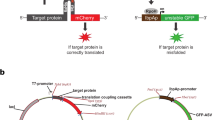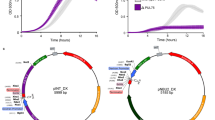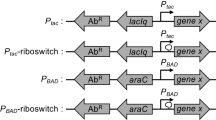Abstract
As a result of the explosive growth of bacterial genomic and postgenomic information, there is a pressing need for efficient, inexpensive strategies for characterizing the in vivo behavior and function of newly identified gene products. We describe here an internal tagging procedure, based on transposon technology1,2, to facilitate the analysis of membrane-bound and secreted proteins in Gram-negative bacteria. The technique is based on a broad–host range transposon (ISphoA/hah), which may be used to generate both alkaline phosphatase (AP) gene fusions and 63-codon in-frame insertions in the genome. The 63-codon insertion encodes an influenza hemagglutinin epitope and a hexahistidine sequence, permitting sensitive detection and metal affinity purification of tagged proteins. For each gene targeted, it is thus possible to monitor the disruption of phenotype (using the transposon insertion), the gene's transcription and translation (using the AP reporter activity), and the behavior of the unfused protein (using the internal tag). Studies on a sequence-defined collection of Escherichia coli strains generated using the transposon showed that the synthesis and subcellular localization of tagged proteins could be readily monitored. The use of ISphoA/hah should provide a cost-effective approach for genome-wide in vivo studies of the behavior of exported proteins in a number of bacterial species.
This is a preview of subscription content, access via your institution
Access options
Subscribe to this journal
Receive 12 print issues and online access
$209.00 per year
only $17.42 per issue
Buy this article
- Purchase on Springer Link
- Instant access to full article PDF
Prices may be subject to local taxes which are calculated during checkout



Similar content being viewed by others
References
Judson, N. & Mekalanos, J.J. Transposon-based approaches to identify essential bacterial genes. Trends Microbiol. 8, 521–526 (2000).
Berg, C. & Berg, D.E. in Mobile Genetic Elements (ed. Sheratt, D.J.) 38–68 (Oxford Univ. Press, New York, 1995).
Kaufman, M.R. & Taylor, R.K. Identification of bacterial cell-surface virulence determinants with TnphoA. Methods Enzymol. 235, 426–448 (1994).
Manoil, C., Mekalanos, J.J. & Beckwith, J. Alkaline phosphatase fusions: sensors of subcellular location. J. Bacteriol. 172, 515–518 (1990).
Ehrmann, M., Bolek, P., Mondigler, M., Boyd, D. & Lange, R. TnTIN and TnTAP: mini-transposons for site-specific proteolysis in vivo. Proc. Natl. Acad. Sci. USA 94, 13111–13115 (1997).
Manoil, C. & Bailey, J. A simple screen for permissive sites in proteins: analysis of Escherichia coli lac permease. J. Mol. Biol. 267, 250–263 (1997).
Manoil, C. & Traxler, B. Insertion of in-frame sequence tags into proteins using transposons. Methods 20, 55–61 (2000).
Hoekstra, M.F. et al. A Tn3 derivative that can be used to make short in-frame insertions within genes. Proc. Natl. Acad. Sci. USA 88, 5457–5461 (1991).
Ross-Macdonald, P., Sheehan, A., Roeder, G.S. & Snyder, M. A multipurpose transposon system for analyzing protein production, localization, and function in Saccharomyces cerevisiae. Proc. Natl. Acad. Sci. USA 94, 190–195 (1997).
Ross-Macdonald, P. et al. Large-scale analysis of the yeast genome by transposon tagging and gene disruption. Nature 402, 413–418 (1999).
Fritze, C.E. & Anderson, T.R. Epitope tagging: general method for tracking recombinant proteins. Methods Enzymol. 327, 3–16 (2000).
Bornhorst, J.A. & Falke, J.J. Purification of proteins using polyhistidine affinity tags. Methods Enzymol. 326, 245–254 (2000).
Britton, L. & Fridovich, I. Intracellular localization of the superoxide dismutases of Escherichia coli: a reevaluation. J. Bacteriol. 131, 815–820 (1977).
Link, A.J., Robison, K. & Church, G.M. Comparing the predicted and observed properties of proteins encoded in the genome of Escherichia coli K-12. Electrophoresis 18, 1259–1313 (1997).
Nossal, N. & Heppel, L.A. The release of enzymes by osmotic shock from Escherichia coli in exponential phase. J. Biol. Chem. 241, 3055–3062 (1966).
Dean, D.A., Fikes, J.D., Gehring, K., Bassford, P.J. Jr. & Nikaido, H. Active transport of maltose in membrane vesicles obtained from Escherichia coli cells producing tethered maltose-binding protein. J. Bacteriol. 171, 503–510 (1989).
Goryshin, I.Y., Jendrisak, J., Hoffman, L.M., Meis, R. & Reznikoff, W.S. Insertional transposon mutagenesis by electroporation of released Tn5 transposition complexes. Nat. Biotechnol. 18, 97–100 (2000).
Herrero, M., de Lorenzo, V. & Timmis, K.N. Transposon vectors containing non-antibiotic resistance selection markers for cloning and stable chromosomal insertion of foreign genes in gram-negative bacteria. J. Bacteriol. 172, 6557–6567 (1990).
Manoil, C. Tagging exported proteins using Escherichia coli alkaline phosphatase gene fusions. Methods Enzymol. 326, 35–47 (2000).
Manoil, C. & Beckwith, J. A genetic approach to analyzing membrane protein topology. Science 233, 1403–1408 (1986).
Acknowledgements
We thank B. Traxler, W.S. Reznikoff, V. deLorenzo, I. Behlau, and A. Wright for discussions and plasmids, A. Alwood, I. Thaipisutikul, E. Round, T. Nguyen, A. Gerum, and Cold Spring Harbor Advanced Bacterial Genetics course participants for experimental contributions, and the National Science Foundation (MCB-9905048) for support.
Author information
Authors and Affiliations
Corresponding author
Ethics declarations
Competing interests
The authors declare no competing financial interests.
Supplementary information
Rights and permissions
About this article
Cite this article
Bailey, J., Manoil, C. Genome-wide internal tagging of bacterial exported proteins. Nat Biotechnol 20, 839–842 (2002). https://doi.org/10.1038/nbt715
Received:
Accepted:
Published:
Issue Date:
DOI: https://doi.org/10.1038/nbt715



